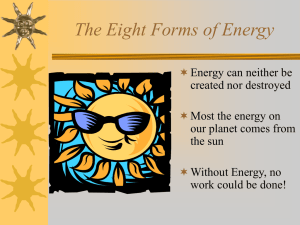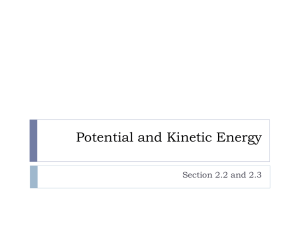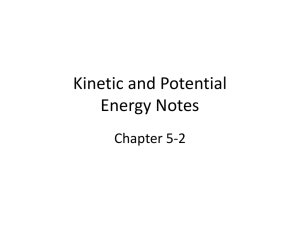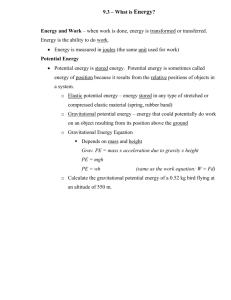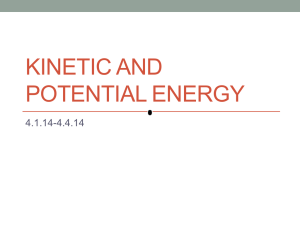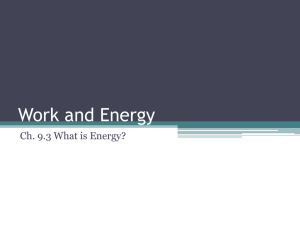Conservation of Mechanical Energy: Mass on a Spring
advertisement
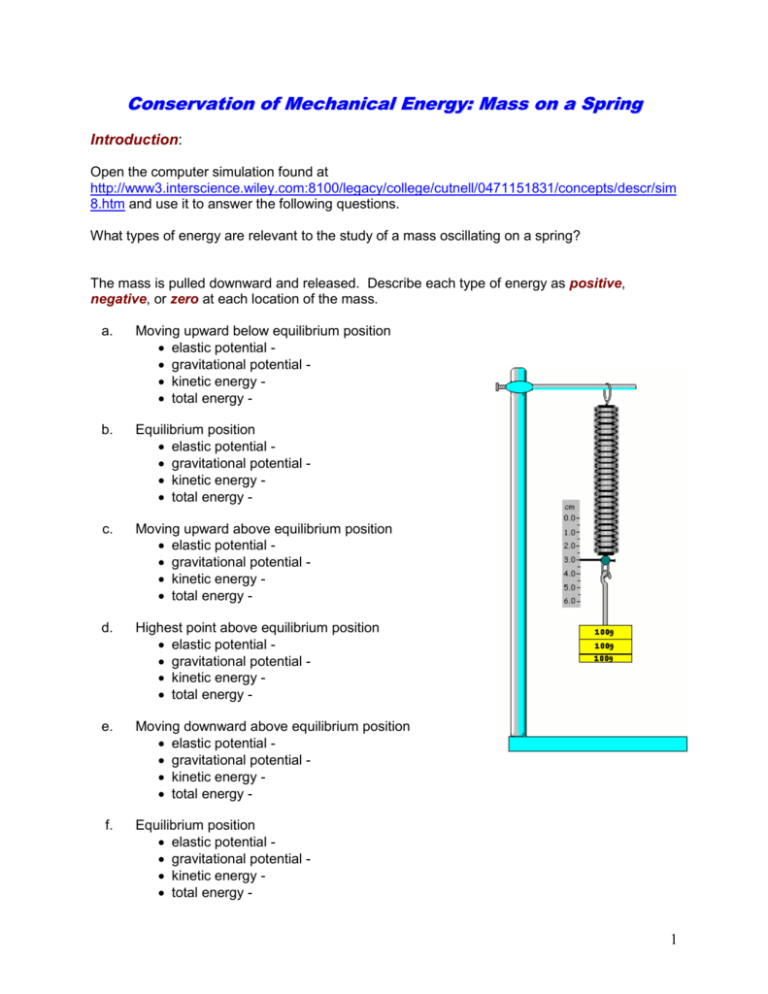
Conservation of Mechanical Energy: Mass on a Spring Introduction: Open the computer simulation found at http://www3.interscience.wiley.com:8100/legacy/college/cutnell/0471151831/concepts/descr/sim 8.htm and use it to answer the following questions. What types of energy are relevant to the study of a mass oscillating on a spring? The mass is pulled downward and released. Describe each type of energy as positive, negative, or zero at each location of the mass. a. Moving upward below equilibrium position elastic potential gravitational potential kinetic energy total energy - b. Equilibrium position elastic potential gravitational potential kinetic energy total energy - c. Moving upward above equilibrium position elastic potential gravitational potential kinetic energy total energy - d. Highest point above equilibrium position elastic potential gravitational potential kinetic energy total energy - e. Moving downward above equilibrium position elastic potential gravitational potential kinetic energy total energy - f. Equilibrium position elastic potential gravitational potential kinetic energy total energy - 1 g. Moving downward below equilibrium position elastic potential gravitational potential kinetic energy total energy - h. Lowest point elastic potential gravitational potential kinetic energy total energy - i. Moving upward below equilibrium position elastic potential gravitational potential kinetic energy total energy - Make a sketch of these types of energy as the spring is pulled downward and released to oscillate through 4 complete oscillations. Label each appropriately. 2 You will now use the Hooke’s Law Apparatus to investigate changes in energy as an actual mass oscillates on a spring. Materials: Hooke’s Law Apparatus, timer, mass, ruler Procedure: 1. Set up the Hooke’s Law Apparatus as before. 2. If available, use a spring with predetermined elastic constant k. If not, perform several trials to determine the spring’s elastic constant. Record your trials in Data Table I. Data Table I Mass, Kg Weight, N Elongation, m Elastic constant, N/m Mass, Kg Weight, N Elongation, m Elastic constant, N/m Average elastic constant = When the mass on the spring is pulled to its lowest position before release, it has a maximum elastic potential energy PEe and a negative gravitational potential energy PEg, assuming the equilibrium position is the zero reference position for height. Since there is no kinetic energy at the highest and lowest points of oscillation, the total mechanical energy of the mass on the spring will be the sum of the elastic and gravitational potential energies at this lowest point. 3. Adjust the apparatus until the pointer on the mass hanger points to the zero position on the mirrored scale when it is held so that it places no force on the spring. 4. Add enough mass to the hanger so that it stretches the hanger a few centimeters. 5. Record this equilibrium position and the total mass in the data table. 6. Gently pull the mass and hanger a few centimeters below this position. 7. Release the mass hanger and observe the highest position the pointer reaches as the mass on the spring oscillates up and down. 8. Record this location. 9. Repeat these procedures three more times using different masses and/or displacements. Data Table II Trial Mass, kg Equilibrium position, m Lowest position, m Highest position, m 1 2 3 4 3 At the highest and lowest positions of the oscillations, the kinetic energy of the mass is zero. The total mechanical energy is therefore simply the sum of the elastic potential energy and the gravitational potential energy. 10. Calculate the energies associated with each trial’s positions and record in Data Table III. Show your calculations in the space below the data table. Data Table III Trial I II III IV Position Gravitational Potential Energy, J Elastic Potential Energy, J highest lowest highest lowest highest lowest highest lowest Kinetic Energy, J Total Energy, J 0 0 0 0 0 0 0 0 Calculations: Conclusion: What sources of error are present in this activity? Does your data support the conservation of mechanical energy of an oscillating spring? Explain. 4


